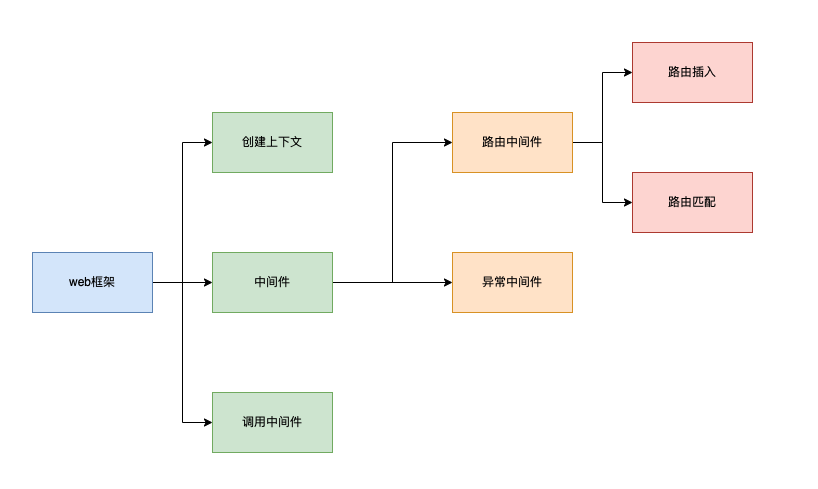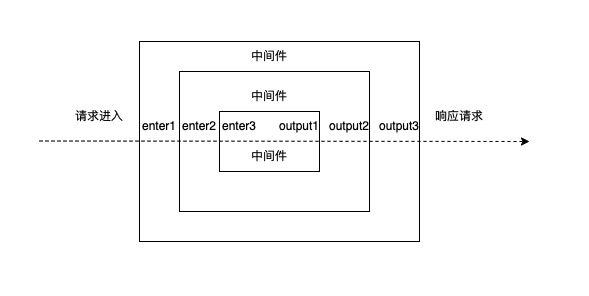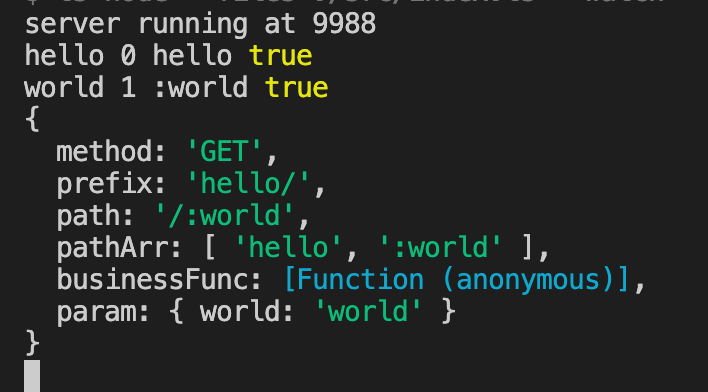title: node实现一个Web服务框架 date: 2022-02-23 14:29:28 updated: 2022-02-23 14:29:28 photos:
- https://img.yzmblog.top/blog/Tl6NXEnaTImyem5bP8P9BlLyo1uundefined.png tags:
- node
- JavaSvript categories:
- 前端
- Web excerpt: 使用过node开发web服务系统的同学通常会使用一些web服务框架。想要知道这些web服务框架是怎么实现的吗?现在就让我们来一起学习一下吧!
使用过node开发web服务系统的同学通常会使用一些web服务框架,例如:express,koa,egg.js等。
想要知道这些web服务框架是怎么实现的吗?在这里将会带你一步一步实现一个web服务端的框架。现在就让我们来一起学习一下吧!
基础知识
node.js中实现http服务主要是用node内置的http和http2库,http库提供了请求和服务端创建功能,使用http库可以很简单地创建一个web服务。
import http from 'http'
const app = http.createServer((req, res) => {
if (req.url === '/') {
res.send('hello world')
res.end()
} else {
res.send('')
res.end()
}
})
app.listen('9988', () => {
console.log('server running at 9988')
})
可以看到在node中只需要几行代码就能开启一个http服务,但是我们会发现直接调用服务的时候会有一个问题:
- 每一个用户访问时,都会调用createServer中的回调函数,当业务逻辑逐渐复杂的时候,回调函数逐渐变得臃肿而难以维护。
如果我们有一个框架,可以帮我们解决url分析,页面参数提取,post参数提取,路由等方法,拿我们的开发效率肯定会提高很多!那我们现在一起实现这个框架吧~
HTTP服务
功能分析
整理一下需求
 上图就是我们的框架需要实现功能
上图就是我们的框架需要实现功能
首先我们需要创建一个Server类,server类提供的是最基本的服务:请求捕捉,封装上下文和触发中间件。
中间件是实现业务逻辑的插件,类似webpack的插件服务一样,当请求进入web服务时就会触发中间件。
所以Server类需要提供最基本的方法:
init: 实例初始化,创建http实例use: 向实例添加中间件listen: 启动web服务createContext:封装上下文runMiddleWare:调用中间件
初始化
初始化需要创建一个HttpFramework类并实现init和listen方法。init是私有方法,会在构造器中调用,代码如下:
import http from 'http';
interface HttpFrameworkMethods {
/** 向实例添加中间件 */
use: (func: middleWareFunc) => void;
/** 启动web服务 */
listen: (...data: ListenOption) => void;
}
/** 监听服务方法传入参数 */
type ListenOption = [port: number, callback: () => void];
/** Http框架类 */
class HttpFramework implements HttpFrameworkMethods {
/** http服务实例 */
private serverApp: http.Server | null;
/** 中间件列表 */
private middleWareArr: middleWareFunc[];
constructor() {
this.serverApp = null;
this.middleWareArr = [];
this.init();
}
/** 初始化 */
private init() {
const app = http.createServer((req, res) => {
});
this.serverApp = app;
}
/** 插入中间件 */
use() {}
listen(port: number, callback: () => void = () => {}) {
this.serverApp?.listen(port, callback);
}
}
export default HttpFramework;
此时已经实现了一个基本的架构,我们实例化之后就可以调用listen来开启web服务
const app = new HttpFramework()
app.listen('9988', () => {
console.log('server running at 9988')
})
// server running at 9988
创建上下文
接下来需要给回调函数构造一个上下文,实现:url分析,页面参数提取的功能
首先定义一下上下文的类型
type PickRequestOptionKey = 'method';
type requestOption<T extends Record<string, any> = {}> = {
_req: http.IncomingMessage;
headers: http.IncomingHttpHeaders;
fullPath: string;
pathName: string;
query: Record<string, any>;
} & Pick<http.IncomingHttpHeaders, PickRequestOptionKey> &
T;
type PickResponseOptionKey = 'statusCode' | 'end' | 'setHeader';
type responseOption = {
_res: http.ServerResponse;
send: (chunk: string | Buffer) => boolean;
} & Pick<http.ServerResponse, PickResponseOptionKey>;
可以看到,上下文需要定义requestOption和responseOption分别对应的是请求进入和请求响应的上下文。
在请求进入时,我们把进行URL分析,将页面参数和请求地址分离,除此之外,还把源请求实例都放入上下文中。
代码实现如下
// 创建上下文
function createContext(req: http.IncomingMessage, res: http.ServerResponse) {
const { method, url, headers } = req;
const { statusCode, write, end, setHeader } = res;
const [pathName, query] = (url || '').split('?');
const queryObj: Record<string, any> = {};
if (query) {
const queryArr = query.split('&');
queryArr.forEach((val) => {
const [key, value] = decodeURIComponent(val).split('=');
if (key) queryObj[key] = value;
});
}
const reqOption: requestOption = {
_req: req,
method: method,
pathName,
query: queryObj,
fullPath: url || '',
headers,
};
const resOption: responseOption = {
_res: res,
statusCode,
setHeader,
send: write.bind(res),
end: end.bind(res),
};
return {
reqOption,
resOption,
};
}
编写完后在回调函数中调用该方法
/** 初始化 */
private init() {
const app = http.createServer((req, res) => {
const { reqOption, resOption } = createContext(req, res);
});
this.serverApp = app;
}
插入中间件
刚刚我们在创建HttpFramework类的时候定义了middleWareArr参数和use方法。
middleWareArr的作用是保存插入的中间件。use方法则是插入中间件方法。
use方法很简单,只需要将传入的中间件存到middleWareArr中即可
type nextTickFunc = () => Promise<any>;
type middleWareFunc<K extends Record<string, any> = {}> = (
req: requestOption<K>,
res: responseOption,
next: nextTickFunc
) => void;
use(callback: middleWareFunc<any>) {
if (typeof callback !== 'function') {
throw new Error('middle ware must be a function');
}
this.middleWareArr.push(callback);
}
可以看到中间件传入了三个参数,req,res和next,req,res是刚刚创建的上下文属性,next则是整个中间件系统中非常重要的一步, 这里参考了koa的洋葱模型
洋葱模型
洋葱模型可以简单地用一张图来描述

一次定义了三个中间件(最外层的是最先插入的中间件),当请求进入时,先执行最外层的中间件,然后执行第二层的,以此类推。
当执行到最后一个中间件后,就会一次执行中间件后的代码,例如在koa中:
import Koa from 'koa'
const app = new Koa()
app.use(async (ctx, next) => {
console.log('1')
await next();
console.log('1')
})
app.use(async (ctx, next) => {
console.log('2')
await next();
console.log('2')
})
app.use(async (ctx, next) => {
console.log('3')
})
app.listen(8080)
代码会依次输出: 1 -> 2 -> 3 -> 2 -> 1
所以,中间件的作用就是:调用多个预先设置好的业务方法,在请求进入的时候递归地调用他们并输出。
调用中间件
上面我们一句实现了插入中间件,接下来需要实现的是:当请求进入时,如何按顺序地调用插入的中间件。
这里使用了递归的方法去实现
/**
* 执行中间件
* @param middleWareArr
* @param req
* @param res
* @param current
*/
async function runMiddleWare(
middleWareArr: middleWareFunc[],
req: requestOption,
res: responseOption
) {
if (middleWareArr.length === 0) {
res.send('404 not found');
res.end();
}
let current = 0;
// 递归调用next函数
async function next() {
if (middleWareArr[current + 1]) {
current++;
await middleWareArr[current](req, res, next);
}
}
// 入口
await middleWareArr[0](req, res, next);
}
最后修改一下init.js
/** 初始化 */
private init() {
const app = http.createServer((req, res) => {
const { reqOption, resOption } = createContext(req, res);
// 调用中间件
runMiddleWare(this.middleWareArr, reqOption, resOption);
});
this.serverApp = app;
}
这样一个基本的Http框架就实现了,来测试一下:
const app = new HttpFramework();
app.use(async (req, res, next) => {
try {
await next();
} catch (err) {
console.log(err);
res.send('error');
res.end();
}
});
app.use(async (req, res) => {
res.send(req.fullPath);
res.end();
});
app.listen(9988, () => {
console.log('server running at 9988');
});
访问http://localhost:9988/hello/world后返回

路由中间件
上文已经实现了一个基本Web框架,但是他没有任何的业务实现。
接下来根据该框架来实现一个路由中间件,用来匹配路由去做对应业务逻辑
功能分析
也是一样,先来分析一下需要实现的功能:
添加路由:添加路由匹配规则路由匹配:根据请求进入的url匹配路由实例的规则动态路由:一个路由规则可以被多个url匹配并收集动态的参数
该中间件主要实现这三个功能,分析完功能后就开始编码吧~
初始化
首先定义中间件类的接口,确定类中需要实现的方法
interface AbstractRouter {
// 路由合并
use: (data: Router) => void;
get: PublicRouteMethod;
put: PublicRouteMethod;
delete: PublicRouteMethod;
post: PublicRouteMethod;
option: PublicRouteMethod;
set: (
method: MethodList,
path: PathMethod,
businessFunc: BusinessFunc
) => void;
routes: () => middleWareFunc<{ route: RouteParam }>;
}
type MethodList = 'GET' | 'POST' | 'PUT' | 'OPTION' | 'DELETE';
type PathMethod = string | RegExp;
type BusinessFunc = (
req: requestOption<{ route: RouteParam }>,
res: responseOption,
next: nextTickFunc
) => void;
type PublicRouteMethod = (path: PathMethod, businessFunc: BusinessFunc) => void;
type RouterParam = {
/** 前置路由 */
prefix?: string;
};
type RouteParam = {
method: MethodList;
path: PathMethod;
pathArr: string[];
prefix?: string;
businessFunc: BusinessFunc;
param: Record<string, any>;
};
创建中间件类
class Router implements AbstractRouter {
public routeList: RouteParam[];
public data: RouterParam;
constructor(data: RouterParam = {}) {
this.routeList = [];
this.data = data;
}
use(data: Router) {}
set(method: MethodList, path: PathMethod, businessFunc: BusinessFunc) {}
get(path: PathMethod, businessFunc: BusinessFunc) {}
put(path: PathMethod, businessFunc: BusinessFunc) {}
delete(path: PathMethod, businessFunc: BusinessFunc) {}
post(path: PathMethod, businessFunc: BusinessFunc) {}
option(path: PathMethod, businessFunc: BusinessFunc) {}
/** 路由匹配 */
routes() {}
}
路由添加
路由添加的方法很简单,只需要解析一下url,构造路由对象,然后插入到路由列表中。主要实现的是set方法,get,post等都是调用该方法
set(method: MethodList, path: PathMethod, businessFunc: BusinessFunc) {
let prefixArr: string[] = [];
const pathArr =
typeof path === 'string'
? path.split('/').filter((val) => val !== '')
: [];
if (this.data.prefix) {
prefixArr = this.data.prefix.split('/').filter((val) => val !== '');
}
this.routeList.push({
method,
prefix: this.data.prefix,
path: `${path}`,
pathArr: prefixArr.concat(pathArr),
businessFunc,
param: {},
});
}
get(path: PathMethod, businessFunc: BusinessFunc) {
this.set('GET', path, businessFunc);
}
put(path: PathMethod, businessFunc: BusinessFunc) {
this.set('PUT', path, businessFunc);
}
delete(path: PathMethod, businessFunc: BusinessFunc) {
this.set('DELETE', path, businessFunc);
}
post(path: PathMethod, businessFunc: BusinessFunc) {
this.set('POST', path, businessFunc);
}
option(path: PathMethod, businessFunc: BusinessFunc) {
this.set('OPTION', path, businessFunc);
}
路由匹配
路由匹配分两种情况:
- 正则匹配:如果匹配规则传入的是正则表达式,则直接使用正则匹配
- 字符串匹配:如果传入的是字符串,则将字符串分割后一级一级地匹配,这样做为了匹配到动态路由的参数。
如果路由匹配成功后,调用方法并立即退出匹配。
代码如下:
/** 路由匹配 */
routes() {
return (
req: requestOption<{ route: RouteParam }>,
res: responseOption,
next: nextTickFunc
) => {
const url = req.pathName;
const urlArr = url.split('/').filter((val) => val !== '');
for (let item of this.routeList) {
if (typeof item.path === 'string') {
const param: Record<string, any> = {};
const pathArr = item.pathArr;
let isMatch = true;
if (pathArr.length !== urlArr.length) continue;
// 匹配路由
for (let [key, val] of Object.entries(urlArr)) {
let index = Number(key);
if (/^\:.*$/.test(pathArr[index]) || val === pathArr[index]) {
if (pathArr[index][0] === ':') {
param[pathArr[index].substring(1, pathArr[index].length)] = val;
}
} else {
isMatch = false;
break;
}
}
if (isMatch) {
item.param = param;
req.route = item;
item.businessFunc(req, res, next);
return;
}
// 正则匹配
} else if (item.path.test(url)) {
req.route = item;
item.businessFunc(req, res, next);
return;
}
}
res.send('404 not found');
res.end();
};
}
写好之后插入到中间件
const app = new Server();
const router = new Router({ prefix: 'hello/' });
router.get('/:world/:hello', (req, res) => {
console.log(req.route);
res.send('hello world');
res.end();
});
app.use(router.routes());
app.listen(9988, () => {
console.log('server running at 9988');
});
运行服务后访问http://localhost:9988/hello/world


可以看到,动态路由可以正则匹配,并且动态路由参数也被记录下来了
总结
本文主要介绍了在node中如何实现一个web框架,主要讲了:
- node.js的http基础
- 构造一个Server框架
- 构造上下文
- 插入中间件
- 洋葱模型
- 调用中间件
- 根据Server框架编写了一个路由模块的中间件
- 路由定义
- 路由匹配
- 动态路由
想看源码的同学可以点击这里